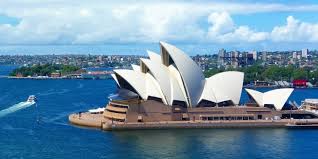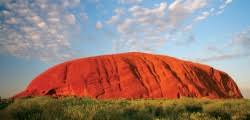In the country of antipodes (part 1)
 There are so many green turtles on the Australian island of Heron in the Great Barrier Reef area that the water is literally teeming with them. Their population here is the largest in the world. In summer, females lay 60 to 200 eggs on reefs, and after two months offspring appear. Turtles freely walk around the island, and a tourist who returns to the hotel should not be surprised if he finds them in his room. This is not dangerous. On the ground, turtles are timid and slow, however, once in the water element, they are transformed. They become agile, agile, movements full of grace. And the strength of turtles is such that they can freely drag an adult on a rope. Naturally, by mutual agreement of the parties.
There are so many green turtles on the Australian island of Heron in the Great Barrier Reef area that the water is literally teeming with them. Their population here is the largest in the world. In summer, females lay 60 to 200 eggs on reefs, and after two months offspring appear. Turtles freely walk around the island, and a tourist who returns to the hotel should not be surprised if he finds them in his room. This is not dangerous. On the ground, turtles are timid and slow, however, once in the water element, they are transformed. They become agile, agile, movements full of grace. And the strength of turtles is such that they can freely drag an adult on a rope. Naturally, by mutual agreement of the parties.
The coastal city of Gladstone in Queensland receives annually more than one hundred thousand tourists who want to visit the Great Barrier Reef. Acquaintance with him can begin from the island of Giron, where there is a research station that studies the life of the sea.
The natural riches of this corner of the planet are amazing, but they are vulnerable. At the beginning of the last century on the islands of Giron and the North-West, a delicacy was made, which was highly appreciated throughout the world – canned meat from turtles. And about half a century before, one phosphate company decided, using cheap power – Chinese workers, to begin the production of bird droppings on Lady Elliot Island. As a result, vegetation over a vast area was destroyed, which affected the entire natural cycle.
The great reef declared by the reserve was also badly damaged due to oil production here and the everlasting companion of this process – pollution of the sea. Deforestation and the development of high-intensity agriculture on the islands adjacent to the reef have led to depletion of the soil.
People are afraid of sharks, and they are afraid of people, but sometimes they are eaten
In the center of the reserve, in the area of the already mentioned island of Giron, there is a huge accumulation of sharks. These predators prefer to avoid humans, fearing underwater guns and harpoons. Their gastronomic needs fully satisfy the food waste that is thrown into the sea. They got used to the fact that garbage from the islands was transported by boat, and the sound of the motor for them was like a call to dinner. There are also large sharks scouring along the coast in search of food. They seem aggressive, but nothing really threatens the swimmers. On the contrary, sharks are particularly cautious when they see people, because they often become victims of underwater hunters.
Defenders of the BDB hope that the protected area will be significantly expanded, and, possibly, over time, the entire area of the Great Reef – and this is an area of 200 thousand square kilometers – will become a reserve. The reserve, but – it must be emphasized – not a resort, which implies a relaxed relaxation among vacationers. Not only touching creatures such as koala bears live here. There are also hordes of individuals dangerous to humans, which can bite, prick or sting at any moment.
Zoologists, immunologists, toxicologists pay great attention to the study of this kind of fauna, trying to find effective ways to deal with the poisons secreted by it. Especially dangerous are the northern regions of Australia. Here, in the waters of the Great Reef, stretching for 2,300 kilometers, very insidious marine inhabitants come across. The most terrible of them are chironix, chiropsalmus and chirodropus cubomedusa. Even the names sound creepy, and a personal meeting with them can be fatal.
According to Bruce Cholested, an American specialist in marine biotoxins, who participated in the compilation of Poisonous and Poisonous Sea Animals of Our Planet, the most formidable aquatic animal known to science is the cubomedusa chironix, also called the “deadly wasp”. Death from her burn occurs within 30 seconds. A fatal outcome, even for a healthy and strong person, can result in defeat by chiropsalmus or chirodropus.
The extremely strong and fast-acting toxin of these creatures penetrates the central nervous system and leads to heart paralysis. Once, an unlucky father taught a six-year-old son to swim in these places and did not notice how the sea “wasp” touched the boy. He cried out loudly and died immediately. Doctors believe that the pain caused by a burn of this animal surpasses all other pain sensations that only fall on a person’s lot. True, the bitten themselves cannot tell about this – there are practically no survivors. Queensland Environmental Specialists say no antidote for this species has been found, although work has been going on for a long time.
The invasion of uninvited guests turned out to be especially massive in the spring of 1984, which was associated with a reduction in the number of sea turtles eating jellyfish. The fact is that the local turtle juveniles attract like coastal lights like a magnet. Often this ends tragically: the fire-worshiping turtles die in the surf.
The National Park Service carried out a wide propaganda campaign to protect turtles on the island of Giron, where, as we already know, there are especially many of them. Literally next to each switch on the coast there is a poster asking if possible to turn off the lights. The islanders were sympathetic to this call. Even those light sources that cannot be turned off, either tried to block the screen from the sea, or reduce their brightness. And it worked: the number of sea turtles dying on the shore has fallen sharply.
Queensland is known not only for its Great Barrier Reef, but also for the Gold Coast, which lies south of it. This is a true paradise for fans of surfing. However, one must not forget about sharks, which are not at all as harmless here as on Girona. Their aggressive habits have been known for a long time. According to the US National Museum, in recent years alone, more than 1,400 attacks by these predators on humans have been recorded in the world. And quite productive: 477 people died – every third.
Especially dangerous are white predators, reaching a length of eight meters, which scientists call sharks-cannibals. One of them recently attacked an Australian resident Anne Dardin, who blithely sailed away from the beach. The punishment was terrible: it was literally streaked in front of shocked vacationers.
There are still places where no man has stepped
If you find yourself in Brisbane, do not forget to visit the “Lone Pine Sanctuary”. Here you will meet with a kangaroo and a platypus, about which it is impossible to say for sure whether he is a beast or a bird. But most attracted to the koala. The most amusing animal! Snoozing in an embrace with eucalyptus in its silvery leaves. I woke up and deftly scratched my big fluffy ear, also silver, with a fluffy paw. He entertained the audience and immediately fell asleep again. With a complacent expression, that is, faces.
Saying goodbye to Queensland, tourists stock up on various souvenirs worth “from the ruble and above.” Serious collectors-numismatists are attracted to coins from the series “Discover Australia”. Cooktown Orchid, a beautiful purple flower that grows on stones and trees, is the emblem of Queensland. Her color image can also be seen on a platinum coin in denominations of 15 Australian dollars.
A gold coin of the same denomination is dedicated to the marine, or rather, the saltwater crocodile. This honor was awarded to the largest on Earth (up to 9 meters long) and a very dangerous reptile, found off the coast of Australia, Indonesia, Sri Lanka and the Solomon Islands. Hunting animals of this species is prohibited by law, however, in 1997, the indigenous inhabitants of the continent received the right to hunt adults. It is believed that the population of these animals has grown too much, reaching about one hundred thousand. But this is far from being the “crocodiles of Gena” …
Tasmania, the only state of Australia located on the island, was named after its discoverer, Dutch explorer Abel Tasman. He came across this piece of land in 1642, but the island was originally named differently – Van Dymen Land – in honor of the governor of East India, who sent a research expedition led by Tasman. Subsequently, one of the largest prisons for convicts, Port Arthur, was created on the island.
For the authorities at that time, Van Diemen’s Land was just a colony that was easy to guard, and for prisoners, on the threshold of hell. The living conditions here were difficult. For half a century, Port Arthur served as an example of the effectiveness of the prison system, which was also very inventive. It was here that corporal punishment was replaced by imprisonment in soundproof cells. Although the island was renamed in 1856, there are still objects that remind of its dramatic past. Today, the ruins of the Port Arthur penitentiary prison are one of the island’s main attractions.




